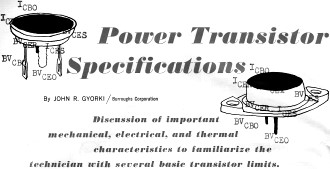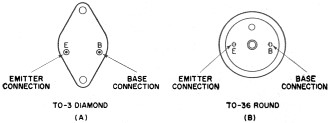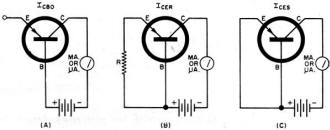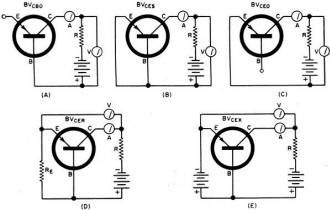|
January 1963 Electronics World
 Table
of Contents
Table
of Contents
Wax nostalgic about and learn from the history of early electronics. See articles
from
Electronics World, published May 1959
- December 1971. All copyrights hereby acknowledged.
|
The basics of power transistor specification and selection have
not changed much since they became widely commercially available
in the 1960s. Although available package shapes, power handling,
cutoff frequencies, and other parameter options have been greatly
expanded, still the most important aspect is not just selecting
a power transistor but properly mounting it to ensure that the
rated heat dissipation capacity will be realized. This article
touches on some of those considerations and how to effectively
deal with them.
Power Transistor Specifications
By John R. Gyorki/ Burroughs Corporation

Discussion of important mechanical, electrical, and thermal
characteristics to familiarize the technician with several basic
transistor limits.
Although a great number of power transistor specifications
can be devised (and the number seems endless), a few of the
more common and important mechanical, electrical, and thermal
characteristics will be discussed. Without a doubt, the sophisticated
power transistor as we know it today would not exist if it were
not for the absolute control of a myriad of fine characteristics
during manufacturing and sorting. However, we are concerned
only with the ratings that decide how we can best keep a device
operating at its highest efficiency.
Mechanical Characteristics
One of the industry's most common power transistor package
styles is the diamond base, also commonly known as the "TO-3."
It has straight pins that can be plugged into a suitable socket
(through a heat sink or radiator) and is usable with emitter
currents of ten amperes or less. Socket connections, however,
are not satisfactory connections and develop voltage drops;
just as voltage drops across a resistance. Also, excessive heating
losses occur when currents above the ten-ampere rating are used.
Therefore, we must utilize a more substantial type of transistor.
Another equally popular style is the round type, "TO-36."
It is generally used for emitter currents of 15 amperes and
above. Two straight pins are used for the base and emitter connections
with holes in them for soldering or they are available with
tinned leads welded directly to short emitter and base studs.
In both types, the collector is mechanically and electrically
fastened to the transistor case. The case serves as the collector
terminal and thermal radiator connection. This is done since
the collector junction becomes very warm during operation. The
emitter and base leads usually can be identified by observing
an "E" and a "B" stamped on the transistor case near the respective
leads. However, this is not always the situation, so a basing
diagram for the particular transistor being used should be consulted.
Fig. 1 shows the typical lead arrangement for both styles.

Fig. 1. Two common power transistor basing
arrangements. In both cases collector is internally connected
to case.
The diamond package is held in place by a 6-32 screw inserted
through each hole in the opposite corners of the heavy mounting
base. The round style is mounted by a single threaded stud projecting
outward from the bottom. A 10-32 nut and lock washer terminal
is used to secure it in place. The recommended torque on the
TO-36 mounting stud is 12 inch-pounds; no more should be used.
Appropriate insulating washers are often used at this time to
electrically insulate the transistor from the heat sink. This
will be discussed more fully under thermal conditions.
Transistors are not mechanically shockproof in themselves.
However, their rigid construction makes them suitable for
use in rugged type equipment. They are hermetically sealed with
a metal cap, either hot or cold welded to the mounting base.
This excludes moisture and light, both of which can degrade
the quality of the device.
Electrical Characteristics
Leakage Current: Collector cut-off currents are simply other
words used for discussing inherent leakage currents associated
with the collector while the base and emitter are held to pre-determined
conditions.
One of the most important collector leakage currents is ICBO
or more commonly, ICO. See Fig 2A. It is a leakage
current from collector to base with the emitter open-circuited
and is critical because it is most susceptible to temperature
variations. Since power transistors operate with high junction
temperatures, changes in ICO could greatly affect
the stability of the transistor and circuit. ICO
can easily be demonstrated by constructing the circuit of Fig.
2A. Heat from your hand or a lighted match brought near the
transistor will change the indicated leakage current enough
to be quite obvious.
Leakage current from collector to emitter with the base circuit
open is termed ICEO. This is a condition that could
be expected in switching applications; the base open and the
collector supply voltage present across the collector and emitter.
In better switching circuits, however, the base circuit is not
entirely open. It is usually reverse-biased or connected to
the emitter by a low value resistor.
Two other collector leakage currents are ICER,
with a specified resistor from base to emitter, and ICES,
with the base shorted to the emitter. They, as well as ICBO,
are measured with the conventional reverse-bias voltage from
collector to base. See Figs. 2B and 2C.
These leakage currents vary from a few microamperes to a few
milliamperes, depending on the specific transistor type. They
are among the most critical power transistor ratings and should
be kept as low as possible. Increased leakage current causes
a rise in junction temperature; a rise in temperature creates
more leakage current. This condition is called thermal runaway
and, if not controlled, could end in the destruction of the
transistor. Outside factors which generally determine the over-all
stability are controlled by the circuit designer.
Voltage Breakdown: Collector breakdown voltage is that reverse
voltage applied between collector and emitter where the collector
current begins to avalanche and the collector current becomes
independent of collector voltage. This constitutes a group of
breakdown voltages where the base and emitter are held to various
constants. One such voltage is BVCBO, the reverse
breakdown voltage between collector and base with the emitter
open. See Fig. 3A.
Two other breakdown voltages are BVCES, base shorted
to emitter, and BVCEO, the base open-circuited. Refer
to Figs. 3B and 3C. These are important considerations when
circuits with inductive loads are used. During transient voltage
peaks the actual instantaneous voltage present between collector
and emitter may be very much higher than the supply. It is at
this time especially we do not want the collector-to-emitter
voltage rating exceeded.
Another breakdown voltage is BVCER. This arrangement
has a specified resistor between base and emitter (usually around
10 ohms). See Fig. 3D.
BVCEX is the reverse breakdown voltage between
collector and emitter with a small reverse bias between the
base and emitter of 0.1 volt or more. This constitutes the absolute
maximum surge voltage limit that the transistor can tolerate.
Steady-state voltages are not used to measure these breakdown
voltages (as may be implied from the diagrams) because of the
excessive junction heating which could destroy the transistor
before final results were tabulated. Rather, a sweep method
is used, employing an oscilloscope and a sine-wave generator
where collector voltage versus collector current can be observed
and the breakdown curve clearly indicated without undue junction
heating. (See "Motorola Power Transistor Handbook," First Edition,
Chapter VIII "Transistor Testing," page 159.)
Collector saturation voltage, VCE (sat), is that
small voltage appearing between collector and emitter with such
large base drive applied (forward bias) that any further increase
in base current will not change the collector current appreciably.
In other words, this is where further collector injection (by
the base) brings to a halt the further increase of collector
current. Current gain is no longer considered existent at these
high current levels. Saturation voltage ratings of most transistors
are measured with a specified value of collector and base current.
Current Gain: Transistor current gain, beta,
is the ratio of a change in collector current to a change in
base current. This is the actual usable current amplification
rating of a particular transistor. Current gain specifications
in power transistors are generally given a range of values for
a specific transistor. These values are known as "large-signal
current gain" and are primarily used over the mean values of
maximum collector currents. "Small-signal current gains" are
sometimes specified for medium- and high-power transistors,
but more generally are considered a special case, since only
a very small portion of the allowable collector current is actually
used. That is, the current gain of a power transistor is much
higher at low collector current levels than at high collector
currents.
Cut-Off Frequency: Current gain frequency
cut-off, fae. (common emitter), is that frequency
where the small-signal current gain of the transistor is 3-db
down from some pre-determined value specified at a particular
frequency. This means that the current gain at fae
is 0.707 of the value specified at some reference frequency
(usually 1 kc.). The actual cut-off frequency is usually 10
kc. for most common power transistors.
Other Characteristics: There are a few other
normal operating characteristics concerning voltage and current
that are important and should be considered.

Fig. 2. Circuits for measuring leakage currents
of transistors.
Maximum emitter current is a common rating and means just
that; the maximum emitter current that can flow before permanently
damaging the device. This is probably one of the first practical
operating ratings considered for either replacement or new design
purposes.
Collector-to-emitter voltage is usually specified with the
base shorted to the emitter or with the base open-circuited.
In either case, the rating is specified with a certain value
of collector current.
Collector diode voltage, VCB (voltage, collector-to-base)
is indicated with a value of emitter-to-base voltage. The actual
circuit supply voltage should be less than the collector diode
or collector-to-emitter voltage ratings.

Fig. 3. The various breakdown-voltage measurements
are depicted.
Base current is usually given as a continuous value or a
maximum value. This base current rating should not be exceeded
or the junction will overheat and destroy the transistor.
Power and Thermal Ratings
Power dissipation and junction temperature rise are directly
related since the rise in junction temperature is caused by
power being dissipated in the junction. The maximum allowable
junction temperature of germanium power transistors is 100°C
(212°F). Any higher temperatures will soften and finally
melt the germanium. The average power dissipation is equal to
the emitter current multiplied by the collector-to-emitter voltage.
This will yield a hyperbolic curve that can be found on typical
output characteristics curves. The transistor circuit load line,
incidentally, must stay under this curve to insure reliable
operation of the transistor and keep excessive power dissipation
in the junction down to a safe level.
Thermal conductivity is the ability of a material to transmit
heat along or through itself. The heat conductivity path from
the transistor collector junction to the ambient air must have
as little heat resistance as possible. Since the junction of
an operating transistor heats and the temperature of the ambient
is normally less than the transistor junction temperature, it
is desirable to have the junction heat radiating into the surrounding
air and allow the junction to approach the temperature of the
ambient. If the heat transfer path from the transistor junction
to the air were 100% efficient, the junction temperature would
be the ambient temperature. However, this is not practically
possible. Between the transistor junction and the ambient air
we find the connection between the junction and the case, case
and insulator, insulator and heat sink, heat sink and air; all
of which total up to an opposition in the path from junction
to air. These obstacles are known separately as thermal resistance.
Each different thermal resistance has a unique coefficient number.
The coefficient of thermal resistance is expressed as a temperature
in degrees centigrade per watt of dissipation. Due to these
resistances, there will always appear a temperature differential
between transistor junction and ambient. This temperature differential
must be reduced to as low a value as possible.
The actual amount of temperature difference depends upon
the amount of power the transistor junction is dissipating.
We add up the individual thermal resistances, multiply the total
thermal resistance by the power being dissipated by the transistor
junction (P = EC x IC and add the results
to the ambient temperature. This gives us the transistor junction
temperature. If the junction temperature just calculated is
over the maximum allowable rating for the transistor, one or
more factors will have to be reconsidered. We can lower the
collector current and voltage to reduce power dissipation (and
consequently the stage output power) or, perhaps, we might lower
the ambient temperature. This could be done by adding a fan
for air circulation or by relocating the assembly in a cooler
environment. Any one of the thermal resistances may be lowered
to accomplish the same end, but this may be a little more difficult
to do. With the new values determined, the junction temperature
must be re-calculated. A useful formula for this is
TJ = PD (θJC + θCS
+ θSA) +TA where: TJ = junction
temperature in degrees C, PD = power dissipation
in watts (collector current x collector voltage), θJC
= transistor thermal resistance in degrees C/watt (junction
to case), θCS = insulator thermal resistance in degrees
C/watt (case to heat sink), θSA = heat sink thermal
resistance in degrees C/watt (heat sink to ambient), and TA
= ambient temperature in degrees centigrade.
Insulators used are mica, Teflon, or anodized aluminum. They
are used only where the collector must be electrically insulated
from the heat sink, but not thermally, Silicone grease applied
in small amounts between the transistor and heat sink (and insulator
when used) can reduce thermal resistance even more, enhancing
total heat dissipation. Teflon has the highest thermal resistance
with mica second and anodized aluminum the lowest. Teflon and
mica are not as mechanically durable as anodized aluminum,
but scratches through the anodized coat on both sides of the
aluminum can electrically short the transistor to the heat sink.
Silicone-coated mica insulators seem to be the most popular
choice at the present time in the industry at large. However,
no insulator at all, with silicone grease between the transistor
and heat sink, is the best possible situation.
The maximum amount of heat transfer takes place in the immediate
vicinity of the mounting studs on the TO-36 package and around
the holding screws on the TO-3 package. The mounting surface
is smooth and made of copper or is plated with another metal,
such as nickel, to enhance thermal conductivity. In general,
securing a heat radiator to the cap of the transistor affords
little or no heat dissipation. The transistor mounting base
surface is the only reliable area for connection to a heat sink.
Conclusion
The many power transistor specifications that are required
in the manufacture of transistors are not necessarily the same
specifications required for field technicians. Once the transistorized
equipment is designed and used, the technician need only be
aware of certain practical and general precautions in the replacement
of transistors, that is, if he does not have a direct replacement,
a substitute may be used. In such a case, a knowledge of a few
transistor characteristics will assist him in making an intelligent
guess as to a proper replacement and insure operation of equipment.
Posted July 30, 2015













